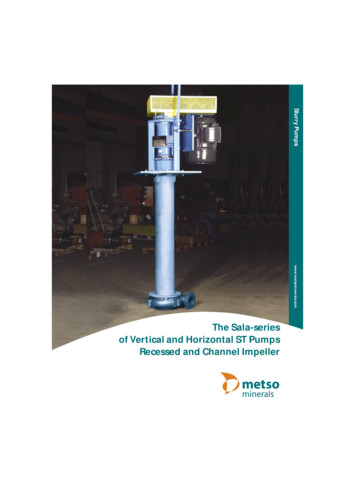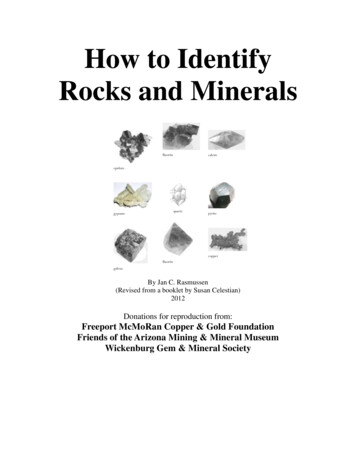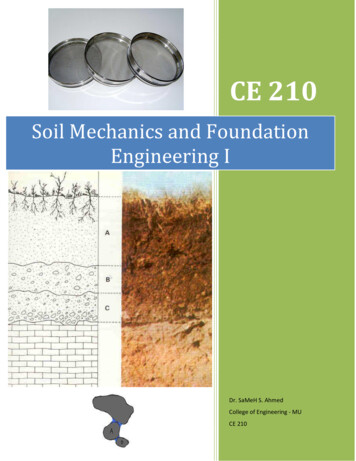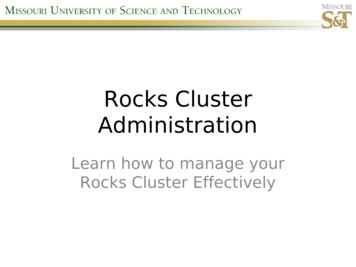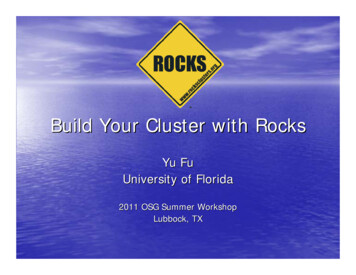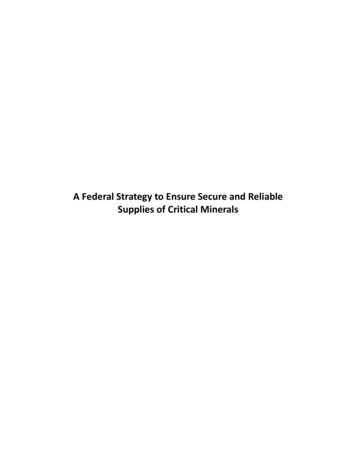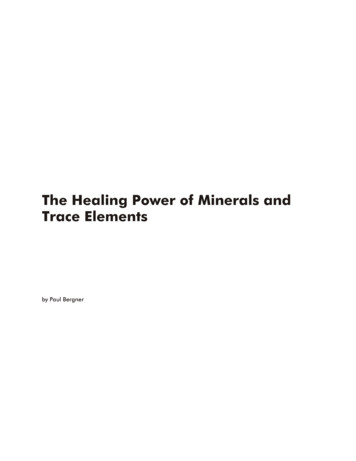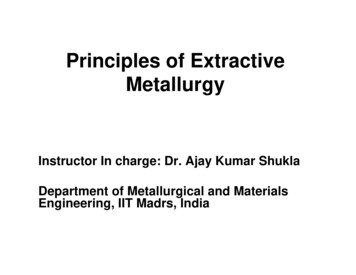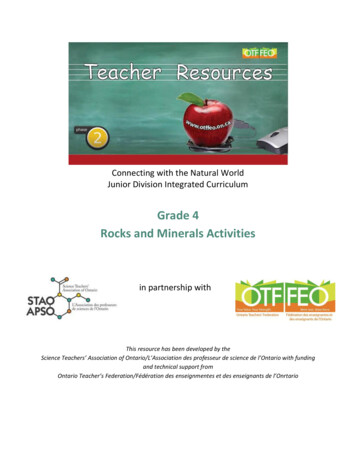
Transcription
Connecting with the Natural WorldJunior Division Integrated CurriculumGrade 4Rocks and Minerals Activitiesin partnership withThis resource has been developed by theScience Teachers’ Association of Ontario/L’Association des professeur de science de l’Ontario with fundingand technical support fromOntario Teacher’s Federation/Fédération des enseignmentes et des enseignants de l’Onrtario
STAO Writing TeamSheila Rhodes, Project Manager, Instructor, Faculty of Education,University of Ontario Institute of TechnologyKimberly Arfo, Curriculum and Instruction, Peel District School BoardSarah Feddema, Durham District School BoardJocelyn Paas, Science and Biology Teacher, Peoples Christian AcademyJudy Wearing, Senior Editor, The Critical Thinking ConsortiumReviewersBonnie Anderson, Peel Field Centres, Peel District School BoardCorrine Brook-Allred, Pickering (Retired)Victoria Winchester, Russell Public SchoolCare has been taken to trace the ownership of copyright material contained in thisdocument. STAO will be pleased to receive and information that will enable it torectify any errors or omissions in subsequent editions. Send comments toinfo@stao.caTeachers are permitted to make copies of this document for their classroom use. STAO/OTF 2012 The material in this document shall not be copied nor reproduced beyond aclassroom without the permission of Science Teachers’ Association of Ontario/L’Association desprofesseur de science de l’Ontario [STAO/APSO]
Table of ContentsOverview for Grade 4 Rocks and Minerals Activities . 4Safety. 4Lesson #1 - How Do Rocks and Minerals Influence Our Lives?. 5Lesson #2 - Identification and Classification of Rocks. 5Lesson #3 - Discovering Human Made Items Which Contain Rocks and Minerals. 5Lesson #4 - Repurposing Items. 5Scenario Approach. 6Junior Geologists . 6Related Activities that assist with integration and use of technology. 7Additional ideas. 8Student Field Guide . 8Fossil Dig – Introduction to Geology. 9Lesson 1 - How do rocks and minerals influence our lives?. 10Minds On 12Connections . 12Action. 12Connections. 13Consolidation 13Extensions. 14How do rocks and minerals influence our lives?.Worksheets. 16Lesson 2 - Identification and Classification of Rocks . 19Part 1: Lesson. 21Minds On. 21Connections. 21Action. 22Connections.24Consolidation. 24Part 2: Lesson. 25Background. 25Minds On. 26Connections. 27Action. 27Connections. 28Consolidation. 28Connections. 29Let’s Rock! Worksheet. 30Part 1 of Lesson Worksheet. 31Part 2 of Lesson Worksheet. 32 STAO/OTF2012 - 2
Lesson 3 - Discovering Human Made Items Which Contain Rocks and Minerals. 34Minds On. 36Connections. 36Action. 36Connections. 37Consolidation. 37Connections. 38Extensions. 38Resources. 38Discovering Human Made Items Which Contain Rocks and Minerals. Worksheet. 39Lesson 4 - Repurposing Items. 40Minds On. 41Connections. 42Action. 42Connections. 43Consolidation. 44Connections. 45Resources. 45Repurposing items containing rocks and minerals – Project Sheet . 46Part 2: Action Worksheet. 47Part 3: Consolidation Worksheet. 49 STAO/OTF2012 - 3
Overview for Grade 4 Rocks and Minerals ActivitiesThe series of lessons provided for the Rocks and Minerals topic of the Science and Technologycurriculum have been developed with the perspective that students learn best when they are able to:interact with their environment, particularly in the out of doors; consider the broader implications oftheir learning; and, work in a collaborative atmosphere of shared knowledge, which furthers the groupas a whole rather than select individuals.The lessons support the ‘Big Ideas’ of this strand, which are: Rocks and minerals have unique characteristics and properties that are a result of how theywere formed. The properties of rocks and minerals determine society’s possible uses for them. Our use of rocks and minerals affects the environment.Concepts that are developed in these lessons include: the earth contains rocks and minerals, which are mined from the ground; rocks and minerals can be identified using various physical characteristics and all rocks will fallinto one of three classification categories; rocks and minerals are used to create things for use in our human environment; there are social and environmental benefits and costs to the extraction, processing, and use ofrocks and minerals; and, there are various options for rock- and mineral-containing items once they can no longer beused for their original purpose. By re-using or re-purposing these items, we are promotingenvironmental stewardship.Cross-curricular connections include Visual Arts in the Repurposing Items lesson.These lessons specifically align to the Grade 4 Science and Technology Rocks and Minerals topic,however there are also connections to big ideas in the Social Studies curriculum, particularly: thathuman activity and the environment have an impact on each other; and, that human activities shouldbalance environmental stewardship with human needs/wants. Other cross-curricular connectionsinclude visual arts in the Repurposing Items lessonThe lessons vary in time required and complexity, ranging from approximately one hour in length tobetween two and three hours in length. There are opportunities in the lessons for differentiatinginstruction, as well as possible ways to extend the lesson and deepen the students’ understanding.SafetySafety in the outdoors should be reviewed in each lesson. A detailed explanation is given in theOverview Section of the entire document, but the following is a brief summary of safety instructions youwill need: STAO/OTF2012 - 4
Take a walk around the area where you would like to bring your class or group and look forsafety issues, both natural (e.g., poison ivy, stinging nettles, etc.) and/or human made ( e.g.,barbed wire fences, broken glass, etc.).Instruct your students on dressing appropriately for the terrain and weather, e.g., proper hikingshoes, sunscreen, hats, backpacks, etc.Have students bring water, if you are planning to be outside longer than 30 minutes.Have students organized in partners and have them work together or in small groups, neveralone.Organize your class activity so that all students are visible to you or are in a clearly marked areawithin hearing distance of your whistle or bell.Lesson #1: How Do Rocks and Minerals Influence Our Lives?This lesson uses student-centred inquiry-based learning to develop an understanding of where rocks andminerals come from; how they are extracted; the effects on the environment of rock and mineralextraction; and the plethora of products in our surrounding environment that are comprised of rocksand minerals.Lesson #2: Identification and Classification of RocksIn this activity, students will observe and test local rocks in order to identify similarities and differences,and to determine if local rock is classified as sedimentary, igneous or metamorphic. This will beachieved using performing and recording and analyzing and interpreting skills for scientificinquiry/experimentation. Students will utilize a Knowledge Building Circle at the end of the lesson toconsolidate learning and engage in further rock and mineral related inquiry.Lesson #3: Discovering Human Made Items Which Contain Rocks and MineralsStudents will go into the schoolyard or local neighbourhood and try to identify human-created itemsthat contain rocks or minerals. They will then further consider the advantages and disadvantages of theitems to the local environment and to the environment in which it was mined. Their work will be peerreviewed.Lesson #4: Repurposing ItemsStudents will bring an item from home containing rocks and minerals that was destined for disposal andwill repurpose it for a new use. The first part of the lesson will take place outside and the students willidentify ways that nature reduces-reuses-recycles (herein referred to as “the 3-Rs”).The class will thendiscuss the 3-Rs from a human perspective. The students will brainstorm new purposes for their itemand propose an idea, which will receive peer and teacher feedback. During the following class, studentswill create their new item and the lesson will culminate with a knowledge-building circle, where thestudents’ creations are shared and the concept of reusing/repurposing is further discussed as a class. STAO/OTF2012 - 5
Scenario ApproachA very effective way of engaging students is through the use of scenarios or story lines as the “hook”.Students really buy into it and it is a great way to integrate many different subjects and topics. Createthe scenarios to take into account different subject areas as well as real-world examples so thatstudents can make connections to what is happening in their local neighbourhood as well as the largerglobal community.Grade Four Rocks and Minerals: Suggested scenario based on becoming “Junior Geologists”Junior GeologistsCome in dressed like a field geologist with a hard hat, pick, and clipboard. Explain that you received atext message over the weekend from the Ministry of Northern Development and Mines asking for yourhelp. You were really not sure what it was all about but you were pretty pumped at this opportunity toget involved in real science. When you arrived at school this morning, there was a package in the officeand it had all these really cool objects inside.Carry in a banker’s box or similar large box that contains books on rocks and minerals, rock samples,tools for digging and excavating rocks, magnifying glasses, and the special letter addressed to the class.Decorate the outside of the box as if it belonged to a field geologist. Have an email, text or letter readyto read to the class. Explain that the letter was sent to you since this grade 4 class is training to become“Junior Geologists”.Create a separate email account for the project. This allows you to send and receive importantmessages from the “Senior Geologist” throughout the activities.“Good morning boys and girls of ** School. I understand that your class is studying all about rocks andminerals. That is a fascinating topic, I must admit. You see, I am a Senior Geologist from the GeologicalSurvey of Canada and we have had a problem over the weekend. I sent a text message to your teacherwho agreed that this class might be able to assist us. Our computer system crashed on Friday night andwe have lost all our data as well as some very valuable samples. We need your help in determining whatrocks and minerals are in your area so that we can start to rebuild our collections and database. Weneed to do some field work to find the answers. Hopefully, you will be able to conduct some scientificexperiments and assist us. These lost samples must be retrieved.” STAO/OTF2012 - 6
Related Activities that assist with integration and use of technology Read the book, “Everybody Needs a Rock “ by Byrd BaylorOn one of the outdoor activities described in the unit, students will be collecting a variety ofrocks from the local area. Students can bring in other samples that they might have collectedwhile on vacation or visiting in other parts of the province or countryAfter reading the book, have students select their favourite rock from the collection on the tableand ask them to “Adopt a Rock”Have them write about their rock. Create a riddle or poem to describe their rock. Anotherperson in their group will try and guess their rock based on their creativityCreate a poster of their favourite rock, including a story or poem using the Voices From the Landproject http://www.sharingvoices.org/Conduct a sample “Fossil Dig” using chocolate chip cookies (described in Additional Ideassection) to get them into the swing of being geologists (check for food allergies first)Make “Mock Rocks” for students to examine to help them understand the composition of index.htmlHave students create a song about their “favourite” ience.htmCreate a geologist field book to record information while outside – use Notes on the iPad or aprogram, such as Dragon Dictation or Voice Recorder, to record informationUse apps on the iPad while outside to try and identify rock sampleso Rocks and Mineralso Rock Houndso Gems and MineralsTake pictures of rocks while outside for use back in the classroomIncorporate the GPS aspect of the camera and record these rock samples on a map of the schoolarea or where excavation took placeMap the route taken to find the rocks and draw the route on return to the classAdd the map and route to programs such as Google Earth or ArcGISHide “special rocks” that the students must find in the school yard or local park. Use GPS andmapping skills to locate them. The students must determine if these are the lost samples basedon research they have done.Have another teacher or parent volunteer act as the “geologist”. Use actual geologists fromProspectors and Developers Association of Canada Mining MattersThis person is in another location as students send back pictures via iPad or Skype. Confirmationcan be sent to students in the fieldComplete the scenario by writing to “scientists” to explain their findings. Must use scientificdataCreate class Blog each day to show what students have discovered and the research they havecarried out (writing and research skills) STAO/OTF2012 - 7
Additional ideasStudent field guideDevelop a student field guide for future students from a locality of choice. Future classes will use thisand contribute. Enlisting the assistance of local geologists to help identify features could also be done.To encourage mapping skills and use of technology, you could use a GPS tool to mark the exact locationof rocks and minerals.Use of rocks and mineralsStudents do an inventory of human uses of rocks and minerals visible in a locality – schoolyard, cityblock, and park. They then consider which use has had the most impact on the environment or whichhas been most important for human progress. Different groups could make different judgments andsee if there is a relationship between human progress and impact on environment. Additionally, theycould specify relationship to children’s uses or school’s uses – all the rocks and minerals visible to theschool’s building and operation. STAO/OTF2012 - 8
Fossil Dig – Introduction to GeologyMaterials: Cookies - one of each type for each person (check food allergies!) Hard chocolate chip cookie Soft chocolate chip cookie Hard raisin cookie Soft raisin cookie Hard cookie Paper towels or foam plates Toothpicks Homemade cookies to eat at end of class!!Procedures:1. Take one of each type of cookie, two paper towels/plates, and six toothpicks.2. Start by excavating in the hard cookies to extract the chocolate chips or raisins using only thetoothpicks. If you break a toothpick so that it is no longer sharp, you can no longer use it. It mustbe discarded.3. After 3 to 5 minutes, stop and find out if anyone was successful in extracting anything. As aclass, review the Discussion Questions below.4. Now excavate with the soft cookies using the same rules.5. After 3 to 5 minutes, stop and find out if you were more or less successful in extracting chips orraisins.How did the results differ between the hard and the soft cookies?Discussion Questions:1. What is the condition of the chips and raisins extracted? Were they whole or broken? Are therebits of cookies still clinging to them or are they relatively clean?2. What was it like trying to remove the raisins and/or chips from the extremely firm cookie?3. Did you get different results from the chips versus the raisins?4. Has anyone used up all their toothpicks already?Extension:Excavating raisins or chocolate chips from a cookie is similar to the work paleontologists do in the field,but working in a classroom is much different from excavating fossils on your hands and knees in the hotsun. To get a more realistic feel for paleontology fieldwork, bury some items in a school garden or otherarea where digging is acceptable, and excavate the items. This time, instead of toothpicks, provide themwith screwdrivers and a garden trowel. STAO/OTF2012 - 9
Grade 4 Rocks and MineralsLesson 1 - How do rocks and minerals influence our lives?Lesson OverviewThis lesson uses student-centred inquiry-based learning to develop an understanding of where rocks andminerals come from; how they are extracted; the effects on the environment of rock and mineralextraction; and the plethora of products in our surrounding environment that are comprised of rocksand minerals.This lesson will take approximately one hour to complete.Connections to Environmental Education The positive and negative consequences, both intended and unintended, of the interactionsbetween human-created and natural systemsCurriculum ExpectationsScience - Grade 4 Understanding Earth and Space Systems: Rocks and Minerals SE1.1 assess the social and environmental costs and benefits of using objects in the builtenvironment that are made from rocks and mineralsSE2.1 follow established safety procedures for outdoor activities and for working with tools,materials, and equipment (e.g., when working outdoors, leave the site as it was found)SE2.6 use a variety of forms (e.g., oral, written, graphic, multimedia) to communicate withdifferent audiences and for a variety of purposes (e.g., use a graphic organizer to show howrocks and minerals are used in daily life)SE3.1 describe the difference between rocks (composed of two or more minerals) and minerals(composed of the same substance throughout), and explain how these differences determinehow they are usedSocial Studies - Grade 4 People and Environments: Political and Physical Regions of Canada OE B2. Inquiry: use the social studies inquiry process to investigate some issues and challengesassociated with balancing human needs/wants and activities with environmental stewardship inone or more of the political and/or physical regions of Canada (FOCUS ON: Perspective)SE B1.1 analyze some of the general ways in which the natural environment of regions ofCanada has affected the development of industrySE B1.2 assess aspects of the environmental impact of different industries in two or morephysical and/or political regions of CanadaSE B1.3 describe some key actions taken by both industries and citizens to address the need formore sustainable use of land and resources STAO/OTF2012 - 10
SE B2.1 formulate questions to guide investigations into some of the issues and challengesassociated with balancing human needs/wants and activities with environmental stewardship inone or more of the political and/or physical regions of CanadaSE B2.2 gather and organize information and data from various sources to investigate issues andchallenges associated with balancing human needs/wants and activities with environmentalstewardship in one or more of the political and/or physical regions of CanadaLearning Goals At the end of this lesson, students will devise answers to the inquiry question that show thatcritical thinking skills were employed. Students could use their own personal experiences ascomparison (e.g., at my house, we dug out a big pit to make a swimming pool and it disturbed abunch of squirrels living in a nearby tree; I think that the impact of a massive pit would affecteven more animals), or they may take previously gathered knowledge and apply it (e.g., I knowthat when I look at the pavement in the playground, it has rocks in it, so I would say that itcontains rocks).At the end of this lesson, through inquiry and collaborating with group members, students willattempt to determine where rocks and minerals come from; how they are extracted; the effectson the environment of rock and mineral extraction; and the plethora of products in oursurrounding environment that are comprised of rocks and minerals.At the end of this lesson, students will have participated co-operatively with group members,engaging in constructive debate.Instructional Components and ContextReadiness Understand the difference between living and non-living thingsDefine the difference between a rock and a mineralKnow the potential uses for rock and minerals (e.g., glass, bricks, asphalt, metal, pencil lead,nails, staples, pop cans, tetra paks, etc.)Materials ShovelsMaterial on which the students can lay out their dirt piles. Examples could be a sheet of thickplastic, plastic bags, construction paper, etc.Project sheet STAO/OTF2012 - 11
Terminology rockmineralliving vs. non-living thingsminingMinds OnTo be done in partners, triads or groups of 4. Can be done inside or outside.Give the students a certain amount of time to answer the following questions on their individual projectsheets. Ideally, they should work collaboratively to answer the questions. This should activate thinkingand prior knowledge. At the completion of the lesson, the students will go back to their initial thoughtsand compare them with their thinking at the end of the lesson.Questions What is the difference between a rock and a mineral?How do we benefit from rocks and minerals? Give two examples of how we do or do notbenefit from rocks and mineralsHow do humans get the rocks out of the ground for use?ConnectionsAssessment for learningCategories addressed: knowledge and understanding; thinking; and communicationThis activity will be filled out on students’ project sheets and will show their initial understandings.ActionConsiderations prior to starting the activityAs it is not advisable to leave the school yard littered with little pits, the dirt could potentially beremoved from: a portion of the yard which is generally unused; underneath a tree where the grassdoesn’t grow and students don’t play; a section of garden; the perimeter of the yard; or an off-sitelocation and brought to school in a few pails. If the dirt is removed from the school yard, ensure that itis put back in its original location when the lesson is done, ideally before the area is used again by theschool community. If there are pits which pose a tripping hazard, ensure that they are marked andstudents are aware of their presence. Do not have tripping hazards present any longer than required.Check with school principal and custodian for assistance and permission. STAO/OTF2012 - 12
Get a shovel full of dirt from your proposed digging location prior to implementing the activity, as youmay find it does not contain the content you desire. For example, if you are digging from a garden,there may be a thick layer of mulch, organic matter, and/or topsoil, which will need to be removed inorder to get to the dirt more likely to contain rocks. Also, many areas are covered in a layer of soil thatmay not be native and unlikely to contain the variety of rocks often present in native soils of Ontario. Sokeep digging, as long as it’s permitted by the school.If you are encountering difficulty obtaining soil samples from your school yard or local area, landscapingcompanies would be a great place to inquire, as they have all sorts of material, including soil fill. Itwould, however, be advisable to inquire about where the fill has come from, as there may becontamination present in soil obtained from commercial, industrial or historic orchards. Parents ofstudents can also be of help in this topic.Can be done inside or outside, but greatest benefit to students would occur outside.Previously arranged groups will each get a chunk of dirt (about a shovelful), which contains dirt androcks.Ask each group to spread out their pile of dirt and list on their project sheet all the non-living things theyobserve. This will require an understanding of the difference between living and non-living things.Pose the following questions to engage students in thinking and investigation; communication; andapplication. Encourage them to look around their surroundings to get ideas. Teacher may providescaffolding as requi
arry in a bankers box or similar large box that contain s books on rocks and minerals, rock samples, tools for digging and excavating rocks, magnifying glasses, and the special letter addressed to the class. Decorate the outside of the box as if it belonged to a field geologist. Have an email, text or letter ready to read to the class.
